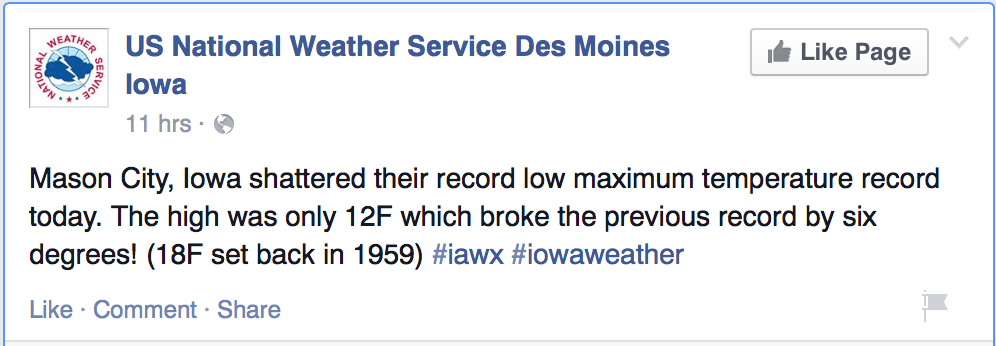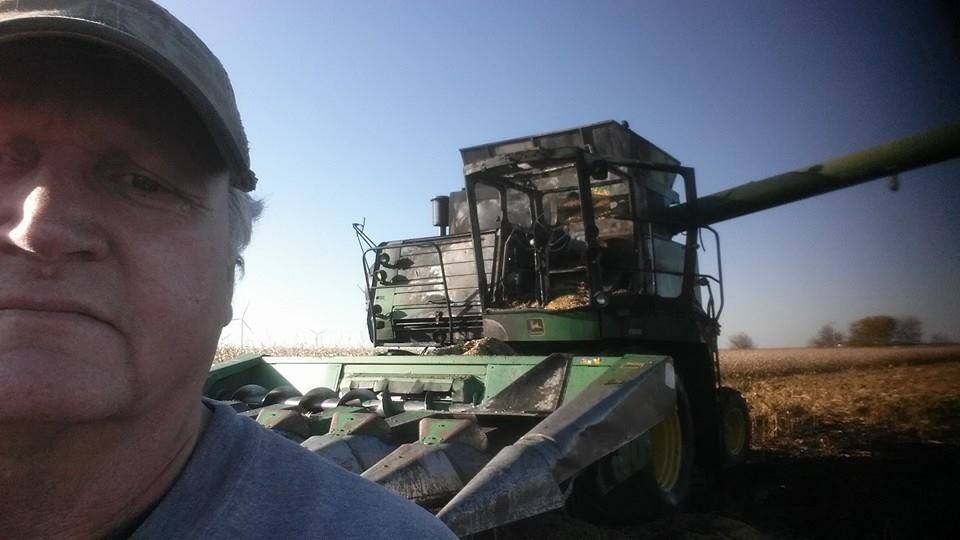-
Latham Hi‑Tech Seeds
Wordless Wednesday | Getting in the Holiday Spirit

-
Latham Hi‑Tech Seeds
Less Government Would Help More Farmers
Here in the Upper Midwest, we have produced ourselves into a period of low prices. Times like these show us which farmers have the deepest pockets as they’re the ones who are taking on more ground.
Last week I heard that another young neighboring farmer is losing most of his crop acreage to an older, larger farmer who is able to pay more in rent. That makes three that I’ve heard about in the last three weeks!
It’s no wonder that the average age of the principal U.S. farm operator is 7.5 times higher than the average age of a farmer in the 1980s. Farmers are 17 years older than the average American worker, according to a recent National Geographic article.
Truth is, there are many young farmers – many with a college degree in hand – who are for an opportunity to farm. It’s just that there are many barriers to entry, including the high price of farmland and equipment.
Any business is hard to start from scratch. But the very capital intense business of farming, with very low or even non-existent margins, makes it next to impossible to get started without help. There are many USDA programs to jump start a farm. There are even tax benefits for those who rent to a young farmer, yet too many barriers remain.
Here are a few barriers that must be removed to help younger farmers:
- Reduce cumbersome regulations that cost farmers’ money. Research shows farmers are likeable people, yet some vocal consumers hate the practices we use. This has led to many regulations. What we need are more people who understand farming and know that farmers – not the government – should decide the best way to farm.
- Remove death tax. If a young farmer is fortunate enough be part of a family farm, then our government shouldn’t make it impossible to keep that farm in the family.
- Our current administration claims to support the middle class, yet life is getting more expensive. The cost of energy tops my list. By limiting how electricity is generated, costs can only rise. Coal and atomic power are by far our most reasonable priced. Making our abundant oil supply more efficient with pipelines and rail also would be a huge help.
Plus, the U.S. needs to stop throwing dollars at our competition! The new Farm Bill is a SNAP for foreign farmers. Building roads and infrastructure in other countries may be a great cause, but we shouldn’t build them with dollars that the American public already thinks of as “American Farmer Welfare.”
The U.S. Farm Bill should not decide who the winners and losers. We can’t keep throwing the huge amount of dollars at the farmers that know how to “farm” the government. I’ve been studying the new farm program that we need to sign up for, and it’s a complicated mess. What a farmer decides right now can make or break a farm, and you have to live with your decision for the life of the Farm Bill!
The U.S. government is getting too complicated and expensive. Too much money thrown at problems that don’t get fixed. I believe most farmers can make it if we can keep the government at bay.
Bottom line: Let the economy and the hard work of farmers decide how the farms in this country will transition. They may get bigger, or they may start many new small specialty farms. However, the current system of government meddling is just going to tilt the transition the wrong way.
-
Latham Hi‑Tech Seeds
Let’s Move this Country Forward!
In this week of Thanksgiving, I’ve been thinking a lot about food – more specifically the growing number of hungry Americans. In 2012, there were 15.8 million kids living in food-insecure homes in this country. A growing number of these children don’t even live in homes! A staggering 2.5 million children – or 1 in every 30 children – are homeless in America.
It’s ironic that food insecurity is an issue in a country where each farmer grows enough food to feed 155 people! As recently as 1960, a farmer only feed 25.8 people. You’d think we’d be making strides in feeding everyone, yet it seems we’re becoming more of a country of “haves and have nots.”
While 1 in 6 Americans struggles with hunger, obesity is becoming a real problem for a growing number of Americans. The percentage of children aged 6–11 years in the United States who were obese increased from 7% in 1980 to nearly 18% in 2012, according to the Centers for Disease Control and Prevention. The percentage of obese adolescents aged 12–19 years increased from 5% to nearly 21% during the same period.
Why is one in five kids in this prosperous country at risk of going to bed hungry? (And I’m not even talking about school lunches!) Is hunger related to the percentage of income it takes in this country to buy food? Data from the U.S. Agriculture Department (USDA) shows that Americans spent only 6.6 percent of their 2012 household income on food. Americans spend less of their income on food than any other country.
Is there a correlation between hungry Americans and the percentage of the food dollar that gets returned to the farmer? This week I’ve been engaged in a related conversation started by farm broadcaster Trent Loos. This online discussion reports that a farmer only receives from 11.6 to 18 cents each food dollar, so this stat alone would suggest that hunger in America is caused by something else.
With a growing amount of welfare support including the Supplemental Nutrition Assistance Program (SNAP), as well as school lunch programs and summer lunch programs, one would think everyone is getting everyone fed! I believe food (in)security is a very complex issue. It’s one that will take time and many different approaches to fix, but I do believe it can be fixed!
It not politically correct for me to say this, I know, but I believe the deterioration of moral values is a major reason we’re seeing an increasing number of homeless and hungry people. When I was child, families were intact and parents took pride in working hard to put food on their own tables. America’s family and living arrangements have changed drastically. The number of single-parent households is on the rise. Broken families are a huge issue; it’s very difficult for a single parent to pay for the costs of living today.
In addition to food and clothing, many Americans now feel entitled to cable TV, gaming systems and smartphones. The average U.S. household today has more televisions than people! Priorities have changed during the past 50 years, and the line between wants and needs has become blurred.
It’s time to stop the attitude of entitlement! Government handouts are not working. Education and training programs all good ways to start. American workers don’t need a PhD, but they do need skills and training to make a good living.
Every student gets a good job when graduating from North Iowa Community College in Industrial Technology (welding, tool and die, diesel technology, building trades). The Iowa State College of Agriculture has a 98% placement rate. It’s being done… this is how we can move this country forward! I truly believe we can do this if we get our values back where they belong!
This Thanksgiving I hope you and your family will enjoy time together and give thanks for all of blessings. Whether you celebrate with ham or turkey, remember wrapping it in #bacon makes everything better. 🙂 Happy Thanksgiving!
-
Latham Hi‑Tech Seeds
Help #CanHunger this Holiday Season
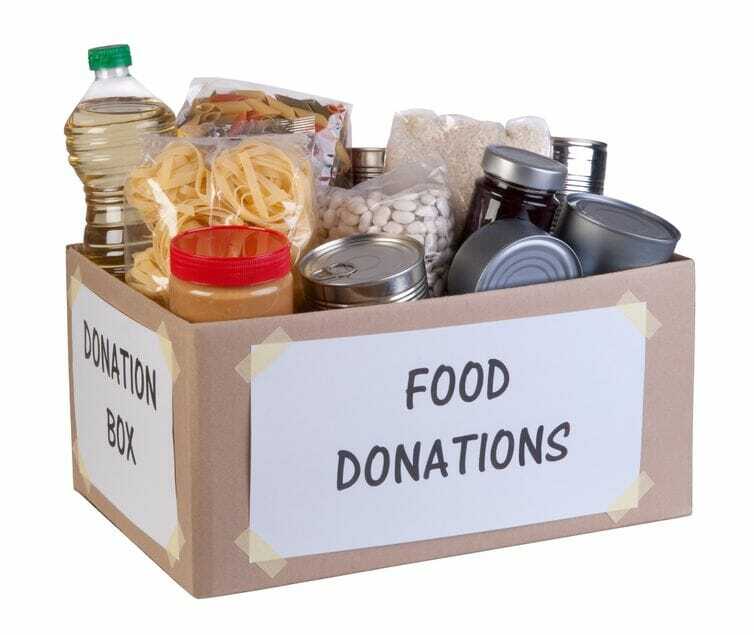
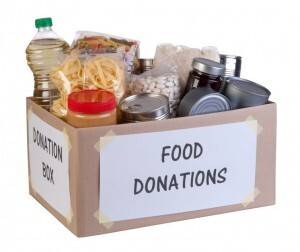 Each year, right before Thanksgiving, confirmation students in our local community conduct a food drive. Last Wednesday night 472 items were collected for the Franklin County Food Pantry!
Each year, right before Thanksgiving, confirmation students in our local community conduct a food drive. Last Wednesday night 472 items were collected for the Franklin County Food Pantry!I’m pleased to say that our family donated to the local food drive. But if I would have known then what I know now, our donations would have been different. First of all, I would have included some toiletries like toothpaste, toothbrush, deodorant and bar soap, plus paper products and garbage bags as these items cannot be purchased with food stamps.
Secondly, I would have made sure my donated items contained more ready-to-go meals like beef stew and chili with meat. I also would have included a box of crackers along with instant soup packets. Finally, I would have donated canned potatoes, carrots and peas because green beans are most often donated. I also would have donated canned fruit other than pineapple, which is most commonly donated.
“We surveyed food banks and the items we found to be most in demand are: canned chicken and canned tuna, peanut butter, soup, boxed meals, pasta, canned veggies and canned fruit,” says Lindsey Haley, Operations Manager for the Iowa Food Bank Association.
If you plan to donate food items to your local food bank, please:
- Choose boxes (rice, potatoes, macaroni, etc.) as bags of food can tear easily.
- Donate low-sugar cereal like plain Cheerios or Raisin Bran.
- Purchase instant meals like oatmeal or biscuit mix that only require water because they’re easier to make.
- Know that cans, cartons or boxes of powered and evaporated milk are always needed.
- Remember that juice boxes, applesauce containers and granola bars make great snacks for kids.
“The best donation a person can make is a cash donation as the food banks can purchase approximately 4 meals for every $1 that’s donated,” adds Haley.
Because $1 can make such a big difference, I’m making a monetary donation this week to help fight hunger. Are you up for the challenge?
The Murphy family from Johnston, Iowa, has issued an open invitation to the #CanHunger challenge, which includes donating to FeedingAmerica.org or to your local food bank. Iowa Girl Eats Kristin Porter and many North Iowa Bloggers have accepted the challenge. You can, too!
Sign a canned food item, donate it to your local food bank, and then challenge three of your friends to do the same. Use the hashtag(#) and see how we can all help make a difference. #CanHunger this holiday season!
-
Latham Hi‑Tech Seeds
Farm Bill is a “Snap” for Foreign Farmers
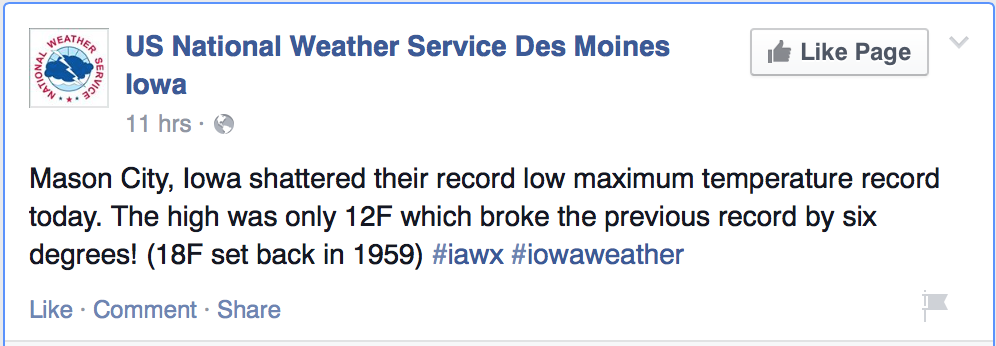
As I did chores yesterday morning, it felt like we were in the middle of January instead of the middle of November! Twenty-mile-an-hour winds whipped snow around the corner of the buildings. I had to make sure the curtains were working to regulate the temperatures inside my hog barns, so I was sweating when I was inside the barn and freezing on the outside. Even as cold as it was outside, 300-pound pigs create a lot of heat inside my barns. That means the curtains must go up and down to keep it comfy for the pigs! The pigs definitely had it better than I as they stayed inside, warm and dry, with the ability to eat and drink whenever they get the urge.
When I saw this weather report, I realized why I felt so miserable:
I don’t even want to know what the wind chill was!
After battling frigid temperatures all morning, I went inside to my office to sort through some of the papers on my desk. I’ve been reading where the billions of dollars go in our Farm Bill. Funding for Supplemental Nutrition Assistance Program (SNAP) accounts for 80% of the Farm Bill, so it would appear U.S. farmers get to fight over the remaining 20%.
SNAP has been a part of the Farm Bill for years, but it’s become an increasingly large budget item. SNAP cost almost $80 billion last year – twice the amount it cost just five years ago! Page 2 of the FY2015 USDA Budget Summary shows that U.S. Farm and Commodity programs only receive 11% of Farm Bill funding, so my curiosity led me to explore where some of this money goes.
It appears that a significant amount of USDA (U.S. Department of Agriculture) funds don’t even support U.S. farmers and ranchers. An article posted Nov. 4 by Joani Dong, Foreign Service Agriculture Attaché, provides an update on The Food for Progress Program. Administered by USDA’s Foreign Agricultural Service, this program helps developing countries like Senegal modernize and strengthen their agricultural sectors using proceeds from U.S. agricultural commodities.
In essence, Food for Progress uses commodities we donate to that country and sells them. For example, a ribbon cutting ceremony was recently held for a 7.5-mile road in Senegal that will help local farmers get products to market. This road links agriculture production zones to the major highway, which is being built with funding from the Millennium Challenge Corporation. Another 10 miles of roads should be completed by year’s end, and a 3-year plans includes the development of 73.3 miles of feeder roads.
Another example of how the USDA’s Food for Progress Program is helping individual farmers expand takes us to Ethiopia. Michael Francom, Agriculture Counselor, U.S. Embassy, Addis Ababa, posted on Sept. 4 how U.S.-donated commodities have helped a small dairy farmer, Ms. Yetemwork Tilahun, expand her farm.
“[Funding] has allowed her to expand her operation from a single dairy cow to her current herd of 10 crossbred Holsteins, each valued at about $3,000 (USD),” writes Francom. “As a result of this expansion, Ms. Yetemwork is not only able to provide her family with fresh milk, but is also able to generate extra income by selling surplus production to several restaurants and hotels, as well as the nearby cooperative.”
These are all good programs, right? Honestly, I’m the type of person that seems to always worry about the whole world. I’m truly concerned for the under fed and the under employed. I would love for the world to be… happy. Yet, the U.S. can’t afford to literally run huge deficits in an attempt to save the whole world.
Let’s focus on helping our own country’s agricultural sector to grow and thrive! I prefer my food grown here, not imported. Unnecessary regulations, cumbersome paperwork and tax burdens drive business out of our country.
-
Latham Hi‑Tech Seeds
What’s the Downside of Food Labeling?

On this Veteran’s Day, I want to begin by saying “thank you” to all who have served. Many American soldiers have made the ultimate sacrifice, but all who have served have been affected in some way. As my friend and fellow ag blogger Janice Person writes, “Observing Veteran’s Day is a small town tradition, a small town commitment. Did you know only 16% of Americans live in small towns but 40% of our military comes from those small towns?”
As Americans, we enjoy the freedom of choice. We are free to choose where we live and work, as well as how we practice religion. The First Amendment also guarantees us the freedom of speech. What I don’t understand, however, is why so many folks believe they also have the freedom to spread misinformation and lies. Yet, this is exactly what’s happening!
“What you put in your mouth is a personal choice,” writes Michele Payn-Knoper in her book No More Food Fights!” What a farmer produces is also a personal choice. One should not overpower the other.”
 With Thanksgiving just around the corner, food production is again top of mind with consumers. I certainly understand why people want to know more about their food. After all, few things are more personal than what we place in our mouths to nourish our bodies.
With Thanksgiving just around the corner, food production is again top of mind with consumers. I certainly understand why people want to know more about their food. After all, few things are more personal than what we place in our mouths to nourish our bodies.Healthy dialogue is needed to promote understanding between producers and consumers. It’s one thing to ask legitimate questions, but it’s quite another thing to develop a fear over certain foods. Too often false information and half-truths are posted online, and those tend to be the articles that come to the top in a Google search.
Why? A blogger who calls herself FoodBabe, has no background in nutrition or food production, yet she has developed a huge following by spreading fear. Dr. Oz, who is a heart surgeon and also “plays” a doctor on TV, gets paid handsomely to spread fear.
Sensationalism sells. Fear sells! If it didn’t, HSUS wouldn’t show videos of sorry looking puppies and teary eyed little kitties. Emotion keeps the cash flowing! If HSUS actually visited a real farm, there would be no audience to play to.
Many groups, like HSUS and those opposing GMOs, instill fear of modern farming practices. Many groups instill fear of modern farming practices like those opposing GMOs. As a result, some large food companies are promoting they’re not part of this “modern style of farming.” Their advertising shows how they only source food from farmers who farm a certain way. Honestly, I believe such ads are merely a marketing tactic. These companies only want to differentiate themselves from the competition in hopes of increasing sales. However, such ads definitely confuse the general public and cause people concern over modern food production techniques.
There’s an entire industry emerging that’s based on food fear, which is also promoting food labeling legislation. Labeling foods as “non-GMO” connotes there is some type of danger. However, there is no proven danger with genetically modified products. There isn’t even a nutritional difference.
Requiring labels for GMO products is redundant and will be costly. Government mandates always cost money. Production prices will increase, and grocery prices will follow. Some affluent people can afford to pay more for food they don’t think they fear, but how will others be affected like the single mother who lives paycheck to paycheck?
Voluntary labeling is already in place… it’s called advertising! If consumers want non-GMOs, all they need to do is buy foods labeled “certified organic.” Consumers already have this choice, yet the food fights continue.
“… the public debate about GMOs isn’t playing out in a constructive way. Both sides have dug trenches, and they’re lobbing grenades over the wall while nothing much changes. It’s the World War I of food issues, and something’s gotta give,” writes Tamar Haspel in a recent Washington Post article entitled, “The GMO debate: 5 things to stop arguing.”
“Stop making these arguments, at least for a while, and see if it doesn’t help,” summarizes Haspel in his Oct 27th Post article. “While you’re at it, reach out to someone you respect who disagrees with you, and listen. If you’re a scientist, academic, activist, journalist or any other type who gets invited to speak on panels, insist that the panel represent both sides fairly; choir-preaching doesn’t help. We need to come to some kind of reasonable consensus on this issue. Give peace a chance.”
Here are some farmers who are reaching out to consumers:
- The truth about your Thanksgiving Turkey by Katie Olthoff
- Understanding food labels by Kim Bremmer
- Ten Truthful Things about Harvest by Wanda Patsche
If you’re a farmer, I hope you’ll follow the examples these ladies are setting. If you’re a consumer, I hope you’ll start following these bloggers.
-
Latham Hi‑Tech Seeds
Tips for Choosing Safe, Healthy Foods for Your Family

 “Behind every good kid is a parent who is pretty sure she’s screwing it up.”
“Behind every good kid is a parent who is pretty sure she’s screwing it up.”I felt like printing off this graphic when I saw it on Facebook and framing it immediately because it verified that someone else shared my sentiment. Parenting is no easy job! As a working mom of two, I have experienced more than my fair share of “mommy guilt.”
There have been many situations I wish I would’ve handled differently with my kids. There are times when I wish work didn’t take me away from home. There are days when I doubt myself and my abilities. The last thing I need is feel guilty about the food that I put on the table to fortify their growing bodies!
But one doesn’t have to take many steps inside any grocery store before doubt and even fear set in…
Organic vs. Natural. Cage Free vs. Free Range. GMO vs. Conventional. Sugar free. Gluten free. Fat free.There are so many different food labels and marketing tactics that suddenly grocery shopping requires a “glossary of key terms.” Our nation has done such a great job of raising large quantities of food that Americans enjoy the luxury of food choice, but too many choices can be overwhelming.
In today’s blog, I’m attempting to bring clarity to a few commonly misunderstood food terms and provide a few simple steps to help every person feel better about the food that goes in his or her shopping carts. Let’s begin by taking a closer look at these three commonly used foodie terms:
- Cage Free vs. Free Range: “Cage free” means that livestock is raised inside a building but not in a cage. “Free range” means the livestock is on the loose, basically living outside. You’ll hear people argue for and against each type, but honestly, it really is a choice that an individual farmer must make based on his/her beliefs, facilities, climate and a variety of other factors.This year I raised cage free chickens inside a building. The main reason my chickens were kept inside is because their purpose in life was to become meat on the table. These chickens were meant for human consumption, not for the dining pleasure of raccoons, weasels, hawks or eagles. Yes, predators are part of the circle of life. When you’re buying chicken feed and spending the time to care for animals, however, you hate to see your hard earned money literally get carried away.
- Organic vs. Conventional: You might be surprised to learn that more than 20 chemicals commonly used in the growing and processing of organic crops are approved by the U.S. Organic Standards. The difference between organic and conventional farming is the origin of the pesticides. However, just because organic foods are raised with no or natural chemicals, doesn’t mean they’re free of harmful things. Organic foods tend to have higher levels of potential pathogens. One study found E. coli in fresh produce from almost 10% of organic farms samples but only in 2% of conventional samples. The same study found Salmonella only in samples from organic farms.Another misconception is that organic foods are healthier. These two methods of production have been studied for more than 50 years, but science cannot find any evidence that organic foods are in any way healthier than non-organic ones. Organic fruits and veggies, just like conventional produce, are dense with nutrients, low in calories and contain antioxidants that help promote health.Feel good about the nutritional value of your fresh fruits and veggies, regardless of how they were raised!
- GMO vs. Non-GMO: What is a GMO? It turns out that most people fear “it” even though they don’t know what “it” is. Click here to see what I mean.The truth is, “modified” doesn’t equal “bad” or “harmful.” Unfortunately, many mainstream reporters and media personalities like Dr. Oz have created confusion by spreading misinformation and using outlandish examples to cause us to fear our food. They make “genetically modified organisms” sound like some evil development.Fact is, farmers have intentionally changed the genetic makeup of all crops grown and livestock they have raised since domestic agriculture began 10,000 years ago! Every fruit, vegetable and grain that is commercially available today has been altered by human hands. Even kale is a genetically modified food. Can you believe that one of the most heralded “super foods” of our time is a GMO?
Headlines throughout the summer produce season have been filled with them merits of kale, but very few acknowledged kale as a GMO. I’ve seen more recipes for Kale Smoothies get shared on Facebook. Why? Consumers are led to believe that the latest buzzword must be good, but as farming advocate Kim Bremmer writes, “…all of these “strategically worded labels” come at the expense of consumers.”
How can you feel comfortable about the food that you feed your family? Follow these easy steps:
- Consider the source. Mainstream media doesn’t always cover both sides of the story nor does it necessarily get the facts straight! Sometimes research findings are influenced by whomever paid for the research. Other times information from a special interest group serves only that group’s best interest. Make sure you’re consulting information from unbiased groups like Best Food Facts.
- Ask questions to a real farmer. Realizing that consumers have questions due to desire to better understand food production, more farmers than ever are sharing their personal farming stories. I regularly read blog posts by farmers who raise type of livestock that I don’t, and I find their stories fascinating. Engage in conversations about food and farming with groups like CommonGroundTM and the Iowa Food & Family Project. Start following hash tags like #RealPigFarming and #foodchat.
- Plan Well Balanced Meals. Whether you buy your food direct from a farmer or pick it up from your local grocery store, give yourself to feel good about the food you’re feeding your family! Take the time to meal plan, including menu items from all food groups. Studies show that when meals are eaten together, the food tends to be more nutritious. Not only that, but research proves that valuable conversations are shared and important memories are created around the family dinner table. At the end of the day, wouldn’t you rather your family have warm memories of good food and good conversation rather than fear and anxiety over what’s on their plate?
-
Latham Hi‑Tech Seeds
“I Never Thought It Would Happen to Me”
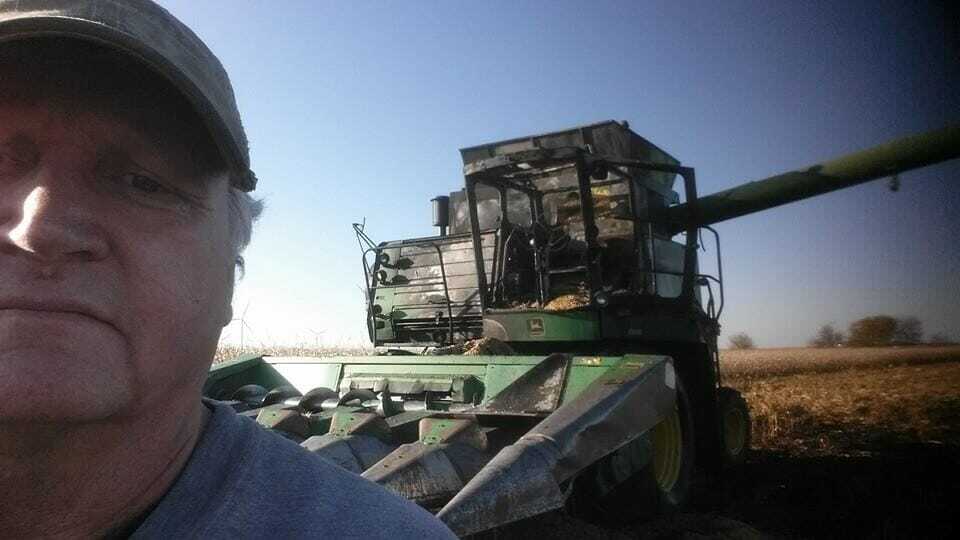
I thought I’d be done combining corn by now, but…
Nothing brings harvest to a halt like a smoking combine! Honestly, I thought I was doing everything possible to prevent a harvest fire. I carry a leaf blower to keep the combine free of chaff and dust, and I carry a big fire extinguisher. But neither was enough to tackle the flames that engulfed my combine last Wednesday.
My wife, Janice, took over running the combine while I drove over to my hog farm to do chores. I was on my way back when I received a frantic phone call from Janice, saying the combine was on fire. Thinking a bearing was probably going out and a little chaff burning, I told her to use the extinguisher. She told me she was calling 911.
Suddenly, my pickup learned how to fly! It didn’t take long to see why Janice wasn’t trying to put out the fire. Smoke and flames were boiling out of the engine beside the cab. I slid in beside the ladder and grabbed the extinguisher and then ran to the engine side. The wind was blowing from this direction, so I could get close enough to spray some powder on the flames. I thought I was gaining on the fire when the powder ran out.
Talking about feeling helpless! Now all Janice and I could do was watch – and use our phones. I used my phone to call the insurance agent. Janice used hers to document the fire.
After a few minutes, I began to wonder why the fire department that is only four miles away in Bradford was not arriving. Because we used a cell phone to call 911, the call went to a different fire department. As time went on, many firemen arrived. The combine was toast by that point, but the corn stalk fire was moving fast. The wind blew the fire away from the standing corn, and the firemen contained the blaze.
I must give Farm Bureau Insurance credit for doing a great job. An adjuster called right away, and when he came out to view the combine, he made sure he did everything possible. He would have done more, but unfortunately I’m a cheap old farmer and didn’t carry as much coverage as I should have. (Did I mention that I took precautions, so I never thought a combine fire would happen to me?) I have already received a settlement check and it hasn’t even been a week!
The outpouring of support has been amazing, too. I posted a picture on Facebook (#felfie of me in front of our charbroiled combine), and Janice posted a video. That video has been viewed about 20,000 times… yes, twenty thousand times!
Offers of help poured in, and neighbors and friends have showed so much concern. The next day I was able to borrow a combine from a good friend, who was done with his harvest. The insurance adjuster gave me the okay to see if the grease seals would hold on my old corn head. There didn’t appear to be any serious damage, so we got my corn head mounted on the borrowed combine and started harvesting corn. This newer machine has been a dream. Janice even let me drive a little! My dog, Tucker, is enjoying the buddy seat. In fact, he’s probably getting a little too comfortable in that seat!
It’s been an emotionally draining week, from the lowest of lows to the highest of highs. Sometimes the good Lord just needs to give a person a wakeup call, and remind him about what’s important. We’re so thankful no one was hurt in this fire! All of our equipment can be replaced, and I might even end up with a little nicer combine now. (So many people have given me leads on used combines for sale!) Plus, I’ve been reminded of just how generous and caring people can be here in the Heartland. #Harvest14 will soon be in the books. In the meantime, stay safe my friends!
P.S. Remember to vote today! Rural America’s vote is important to preserve our livelihoods and our freedoms.
-
Latham Hi‑Tech Seeds
Livestock Producers Demonstrate Effectiveness of Quarantine
October is coming to an end, and I must talk about pork before it’s over!
The last few weeks I have written how my mother-in-law’s 90th birthday celebration gave us a reason to look through old family albums and reflect upon the good old days. The Iowa DNR (Department of Natural Resources) recently released an historical aerial map photo project, dating to the 1930s.
As I looked through these maps of old farmsteads, I noticed a difference in buildings. What an amazing look through history of farming! The buildings, like our equipment, have completely changed. We have gone from hand labor cleaning the barns to mechanization, from pitch fork to pumps to for manure removal. I can see how this natural fertilizer was applied to the fields by looking at these maps.
In the past, manure was moved with horses so it most often got applied close to the building site. The soil tests taken when I started farming in the early 1970s proved this as the fertility around the buildings was sky high; the fields farthest away from the building site were very low in fertility. The manure was valued but not scientifically applied.
Today’s pork producers understand the value in applying this natural fertilizer where it’s needed. Producers keep records of manure application, such as the method (injection, incorporation, etc.), date of application, field location, number of acres, and application rate.
Just as we’ve developed more scientific ways of applying natural fertilizer and modern equipment technology now allows us to inject or incorporate the manure right into the soil, today’s pig farmers also have made great strides in controlling disease outbreaks.
In the late 1980s, I was on the Iowa Pork board as chairman of the Feeder Pig Committee. It was decided that the pork industry would eradicate pseudorabies. Pseudorabies is an extremely contagious disease that causes reproductive problems, including spontaneous abortion, stillbirths and death losses in breeding and finishing hogs. While the disease is not a threat to humans and the meat from infected animals is not contaminated, pseudorabies can wipe out a herd. The financial impact from pseudorabies was huge for farmers, as well as for the state.
Pork production generates billions of dollars annually for Iowa’s economy. Iowa pork producers raise more than 17 million pigs, or 28% of the nation’s pork supply. It goes without saying that eradicating pseudorabies was a huge undertaking!
Veterinarians developed an eradication plan that was put into action. Because some areas of Iowa’s pork production were completely shut down, it was devastating to many pork producers. Feeder pig shows were especially hit hard, but it worked! A press conference was held in July 2004, declaring our state free of pseudorabies.
Today Ebola is making the headline news. We know quarantines can be effective in stopping the spread of this disease, they cause hardships for medical professionals. In fact, some medical professionals might even avoid volunteering to help fight Ebola due to the quarantine.
While it may not be fun or convenient, being quarantined for 21 days is an extremely small price to pay when you think about it! Livestock production has proved time and again that quarantine is an effective way of stopping the spread of deadly disease.
Stopping the spread of Ebola is certainly a concern, and we don’t want it to become an epidemic. However, there are so many other problems this world: starvation, political unrest, terrorism, the right to life… Is anyone making a list and trying to put things in order of importance?
Next week’s election is a good place to start showing your priorities! Then after the election, let’s keep the official’s feet to the fire. Talk to your elected officials at all levels, and let them know what you expect. Then remember to keep talking to them because bills get passed and regulations get made all year long.
-
Latham Hi‑Tech Seeds
Revisit the Past, Gain Appreciation for the Present
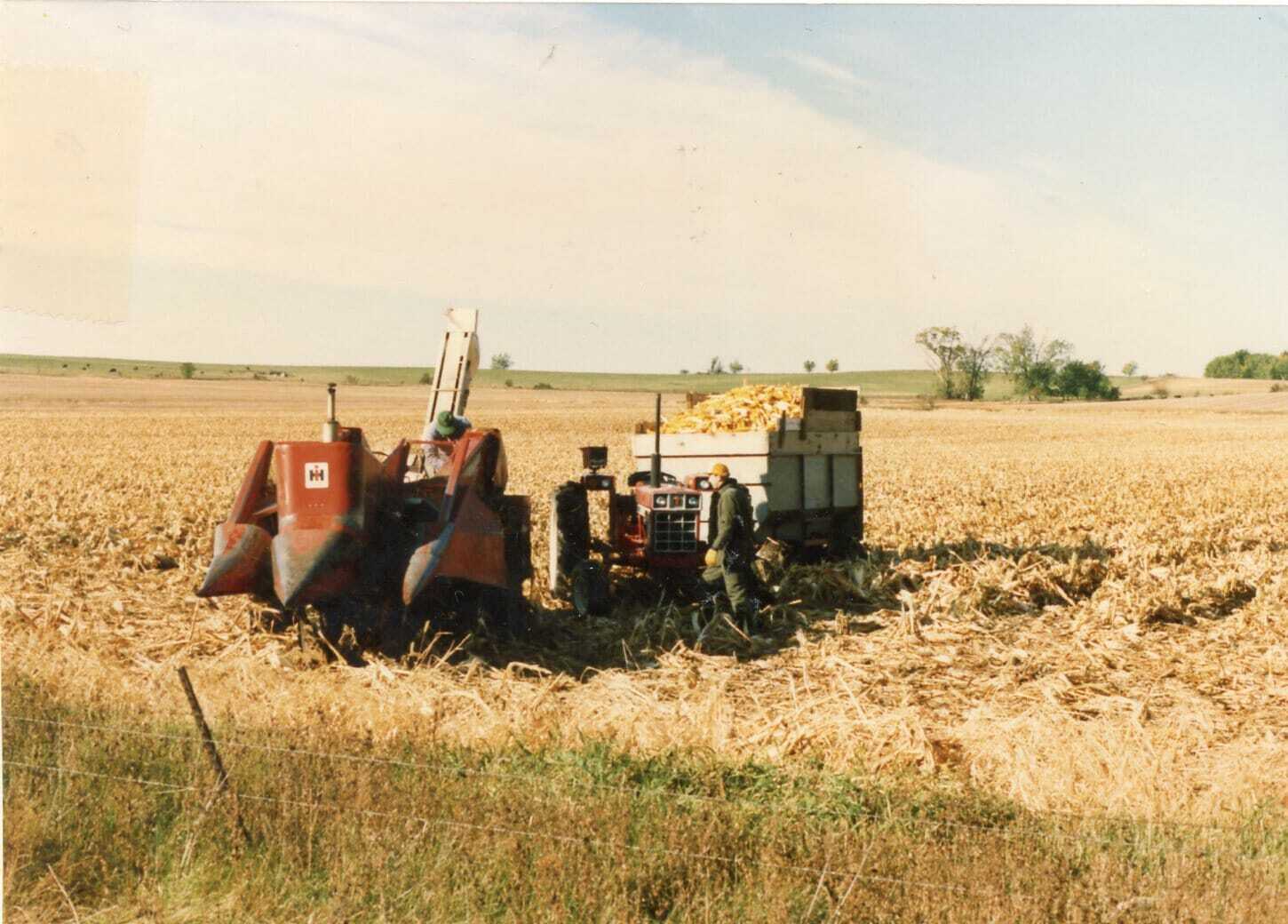
This past week we celebrated my mother-in-law’s 90th birthday! My wife, Janice, conducted research and gathered photos to make a 22-minute video that showcased her parents’ lives – as well as told the story of farming – during the past nine decades.
Honestly, many of those photos from the family album showed the hardships of farm life. Just imagine farming before tractors and electricity! Yet, year after year the Rewerts family kept farming. You can see how everyone in the family pitched in: planting crops, taking care of those crops including pulling weeds by hand, picking ears of corn, storing those ears until they were dry and then shelling corn in July. I remember those hot, dusty days! I also remember cold, winter days when we had to go outside to do chores in snow so deep that it almost went over the barn!
It was fun to journey down Memory Lane. After looking at photos of those old cars and trucks, I’m truly amazed at how those old trucks got the job done. Those first vehicles didn’t have radios either. Speaking of radios, notice how big those first radios were. They took up a great deal of space in a house, so there was no way they would’ve fit in a dash. Of course, there weren’t computers, cell phones, video games or GPS systems then either.
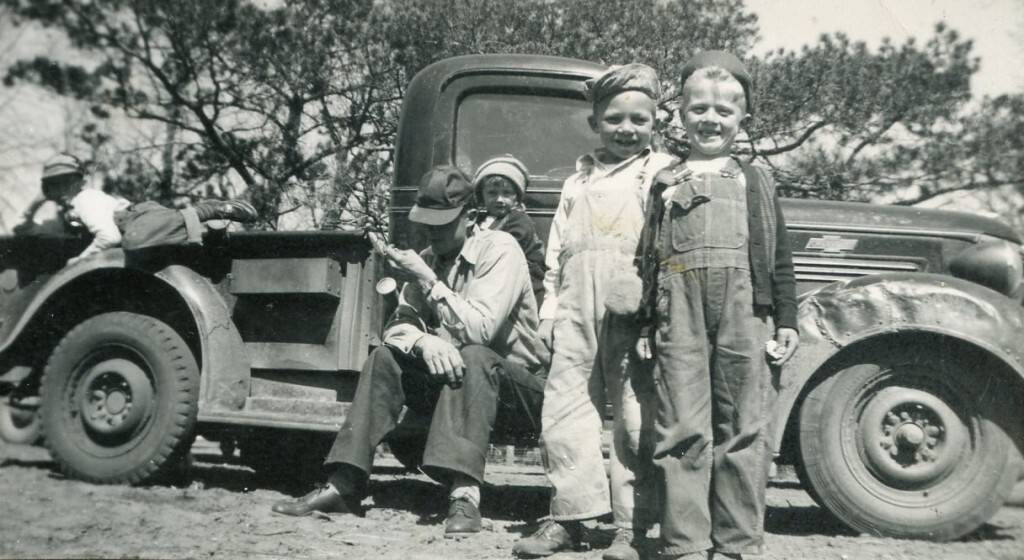
Yesteryear’s farm truck… somehow it got the job done! What a contrast between those first tractors without even power steering to today’s tractors that can actually steer themselves! Combines now can harvest the same amount in minutes that was harvested in hours when my mother-in-law was young.
Not only has farm machinery and equipment changed, but even the crops have changed. Honestly, farming has changed drastically just within the last 20-25 years due to the introduction of first Roundup Ready® soybeans and then traited corn products. Now we have corn hybrids that fight weeds and bugs on their own.
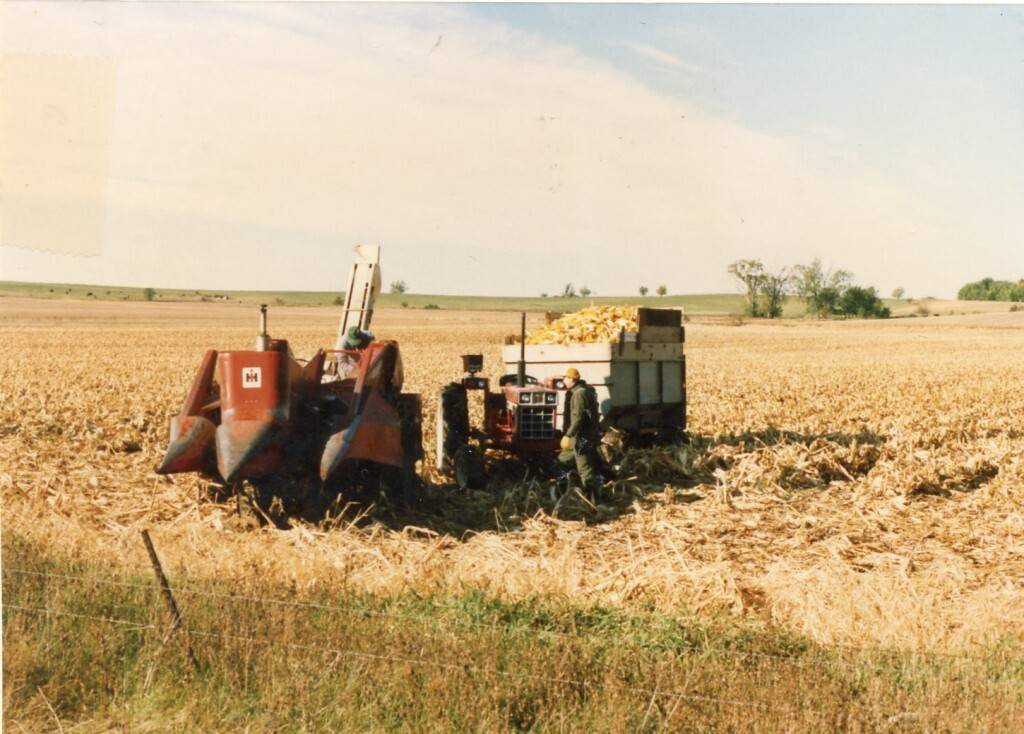
Picking corn that would be dried in a corn crib and then ground for livestock feed Even the food on our tables has changed in the last 90 years. When Grandma was young, everything was made from scratch. No one worried about how many calories were consumed because it was all worked off by the enormous amounts of manual labor that was done. Today’s society is not only concerned with calories and nutritional content, but many consumers want to know how the food was produced.
So much has changed! I’ve had a great time the last couple weeks reminiscing about the good ol’ days, but I’ll be the first to admit that I’m glad to be farming today. Earlier this fall I attended a Threshing Day where I saw them harvest the same amount of oats in three hours that could be harvested by a combine in just 10 minutes! Earlier this month I participated in the 4th Annual Franklin County Harvest Blogger’s Tour where we visited our county’s agricultural museum and then gave non-farmers rides in combines.
My understanding of farming history helps me appreciate farming today! It’s great to be able to use today’s technology to grow my crops, raise my pigs, and even be able to communicate with all of you!

